Jaipur
|
| Jaipur , also popularly known as the Pink City, is the capital and largest city of the Indian state of Rajasthan. During the British rule in India, Jaipur was the capital of the princely state of Jaipur. Founded on 18 November 1727 by Maharaja Sawai Jai Singh II, the ruler of Amber, the city today has a population of more than 3.2 million.
Jaipur is the first planned city of India, located in the semi-desert lands of Rajasthan. The city which once had been the capital of the royalty now is the capital city of Rajasthan. The very structure of Jaipur resembles the taste of the Rajputs and the Royal families. At present, Jaipur is a major business center with all requisites of a metropolitan city.
The city is remarkable among pre-modern Indian cities for the width and regularity of its streets which are laid out into six sectors separated by broad streets 111 ft (34 m) wide. The urban quarters are further divided by networks of gridded streets. Five quarters wrap around the east, south, and west sides of a central palace quarter, with a sixth quarter immediately to the east. The Palace quarter encloses a sprawling palace complex, (Hawa Mahal), formal gardens, and a small lake. Nahargarh Fort, which was the residence of the King Sawai Jai Singh II, crowns the hill in the northwest corner of the old city. The observatory, Jantar Mantar, is one of the World Heritage Sites. Jaipur is a popular tourist destination in Rajasthan and India. |
General Information
|
| Jaipur is the capital and the largest city of the state |
Tourism Spots
|
| Hawa Mahal |
Hawa Mahal is a palace in Jaipur, India. It was built in 1799 by Maharaja Sawai Pratap Singh, and designed by Lal Chand Usta in the form of the crown of Krishna, the Hindu god. Its unique five-storey exterior is also akin to the honeycomb of the beehive with its 953 small windows called jharokhas that are decorated with intricate lattice work. The original intention of the lattice was to allow royal ladies to observe everyday life in the street below without being seen, since they had to observe strict "purdah" (face cover). |
|
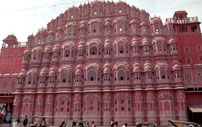 |
|
| |
| Amber Fort |
| Amber Fort (also known as Amer Fort) is located in Amber, 11 km from Jaipur, Rajasthan state, India. It was the ancient citadel of the ruling Kachhawa clan of Amber, before the capital was shifted to present day Jaipur. Amber Fort is known for its unique artistic style, blending both Hindu and Muslim (Mughal) elements, and its ornate and breathtaking artistic mastery. The fort borders the Maota Lake, and is a major tourist attraction in Rajasthan. |
|
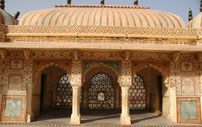 |
|
| |
| Jaigarh Fort |
| Jaigarh Fort, located around 15 km from Jaipur, is one of the most spectacular forts in India, with almost all its original facilities intact. While Jaigarh Fort is on top of the hill, Amber Fort is at the bottom. The forts are connected through well-guarded passages. Many consider the two together as one complex.
Jaigarh Fort was a center of artillery production for the Rajputs and it is home to the world's largest cannon on wheels, the Jaivana. The foundries provide fascinating information for the visitors. The manner in which they drew in blasts of air from the desert is most intriguing. A 5km long canal can be seen entering the fort complex to bring in water from the high hills and store in the fort for the armymen. A huge water tank is centrally located connecting the canal. It is assumed that the Kings of Amber/Jaipur used the compartments below the water tank to store the gold and jewellery of the royal family. It is said that this tank was opened during the Emergency declared by the Indian Prime Minister Indira Gandhi during 1975-1977. Views of the barren Aravalli Hills gradually disappearing into the desert haze can keep one engrossed for hours. |
|
 |
|
| |
| Nahargarh Fort |
| Nahagarh Fort stands on the edge of the Aravalli Hills, overlooking the pink city of Jaipur in the Indian state of Rajasthan. The view of the city from the fort is breath taking. Along with Amber Fort and Jaigarh Fort it formed a strong defence ring for the city. During the Sepoy revolt of 1857, Nahagarh served as a refuge for Europeans fleeing from the havoc created by mutineers in neighboring states. |
|
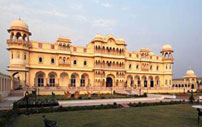 |
|
| |
| City Palace |
| City Palace, Jaipur, which includes the Chandra Mahal and Mubarak Mahal palaces and other buildings, is a palace complex in Jaipur city, the capital of the Rajasthan state, India. It was the seat of the Maharaja of Jaipur, the head of the Kachwaha Rajput clan. The Chandra Mahal palace now houses a museum but the greatest part of it is still a royal residence. The palace complex, which is located northeast of the centre of the grid patterned Jaipur city, incorporates an impressive and vast array of courtyards, gardens and buildings. The palace was built between 1729 and 1732, initially by Sawai Jai Singh II, the ruler of Amber. He planned and built the outer walls, and later additions were made by successive rulers right up to the twentieth century. The credit for the urban layout of the city and its structures is attributed to two architects namely, Vidyadar Bhattacharya, the chief architect in the royal court and Sir Samuel Swinton Jacob, apart from the Sawai himself who was a keen architectural enthusiast. The architects achieved a fusion of the Shilpa shastra of Indian architecture with Rajput, Mughal and European styles of architecture. |
|
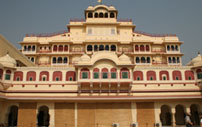 |
|
| |
|
Jantar Mantar |
| The Jantar Mantar is a collection of architectural astronomical instruments, built by Maharaja (King) Jai Singh II at his then new capital of Jaipur between 1727 and 1734. It is modeled after the one that he had built for him at the Mughal capital of Delhi. He had constructed a total of five such facilities at different locations, including the ones at Delhi and Jaipur. The Jaipur observatory is the largest and best preserved of these. It has been inscribed on the World Heritage List as "an expression of the astronomical skills and cosmological concepts of the court of a scholarly prince at the end of the Mughal period". |
|
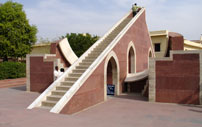 |
|
| |
| Jal Mahal |
| Jal Mahal (meaning "Water Palace") is a palace located in the middle of the Man Sagar Lake in Jaipur city, the capital of the state of Rajasthan, India. The palace and the lake around it were renovated and enlarged in the 18th century by Maharaja Jai Singh II of Amber.
The urban lake gets filled up during the rainy season; over the years, once the reservoir became full during rainy season, it got covered with Hyacinth. During this period the red stoned palace became approachable only by boat and through a causeway, and presented a spectacle on the way to Jaipur city from Delhi. |
|
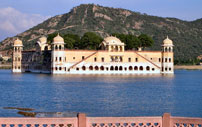 |
|
| |
| Rambagh Palace |
| The Rambagh Palace in Jaipur, Rajasthan is the former residence of the Maharaja of Jaipur and now a luxury Taj Palace Hotel, located 5 miles (8.0 km) outside of the walls of the city of Jaipur on Bhawani Singh Road. |
|
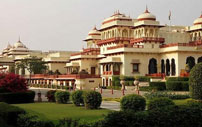 |
|
| |









